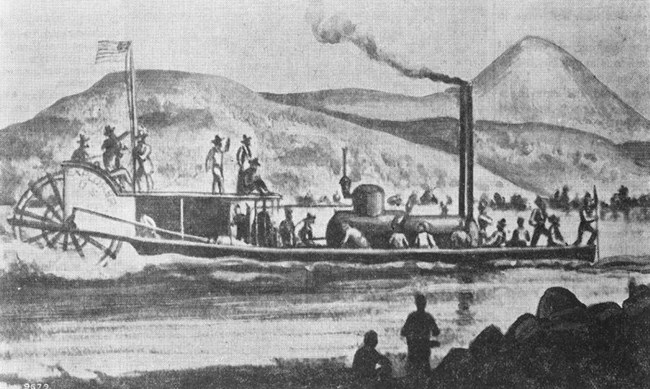
Steamboats of History’s PastPreviously used along the lower portions of the Colorado River, steamboats provided an important service in transporting people and goods between Pacific Ocean settlements, mines, and ports. The steamboats typically operated from the southernmost Colorado River Delta area (Gulf of California in Mexico), northwards to the Virgin River from 1852 to 1909. The landing ports were scattered throughout the Mexican state of Sonora and California, Nevada and the Territories of Baja California, Arizona, and New Mexico in the United States.The steamboats also traveled the Colorado River’s tributaries on the Green River in Utah and Wyoming in Glen Canyon along the Grand River, all now collectively referred to as the upper Colorado River. While other transportation methods met with scarce success, steamboats remain a major part of our aquatic history and paved the way for travelers transporting goods between settlements. 
Uncle SamThe first steamboat to chug up the Colorado River was a side-wheel paddle steamboat designed by Domingo Marcucci in June of 1852. In November 1852, James Turnbull, a contractor who began supplying for Yuma, delivered the segments of the 65-foot long steamer to the Colorado River Delta waters from San Francisco with a schooner called Capacity.The steamboat was reassembled and launched in the estuary about 30 miles north of the delta at the mouth of the Colorado River. Marcucci’s Uncle Sam and its 20-horsepower engine could carry only 35 tons of supplies and took 15 days to make its first 120-mile voyage. For four months, the steamboat made countless trips along the river to transport the supplies needed for Fort Yuma and with experience, reduced the travel time of its route to only 12 days. Due to carelessness, Uncle Sam sank at its dock below Fort Yuma, where it was then washed away in the spring flood of 1853. Captain Turnbull later returned to San Francisco for a new hull for Uncle Sam, leaving the army to send wagons to collect cargo from the delta. After facing financial difficulty, Turnbull vanished from San Francisco leaving many unpaid employees. Despite the scandalous ending to his steamboat ventures, Turnbull showcased the importance of steamboats in meeting Fort Yuma’s supply needs, providing Uncle Sam a historic role in the use of steamboats on Colorado River routes. 
CocopahCocopah, the largest in the Colorado River steamboat service era, first launched in August of 1859. The stern-wheel paddle steamer was built for the expensive amount of $35,000 (over $1.1 million today) by the George A. Johnson & Company in San Francisco and was the fifth steamboat to work along the Colorado River. Cocopah’s sturdy engine could carry up to 100 tons of cargo – even against the strongest of river currents.The steamboat was 140 feet long, 29 feet wide, and had a shallow draft of 19 inches, even with full cargo, making it perfect for facing low water levels and sandbars. Cocopah was originally built to replace Johnson’s first boat, General Jesup, before it was later disassembled and transported from San Francisco to the Colorado River. After reassembly at Gridiron Landing in Sonora, Cocopah was officially launched in August of 1859 and captained by David C. Robinson - an experienced captain who formerly steered the steamboat Explorer in a Colorado River voyage. The Cocopah continued its travels along the Colorado River until it was retired in 1867. The boiler and engine were removed, and the Cocopah was moved onshore - becoming housing for workmen in Port Isabel, Sonora. 
ExplorerIn 1857, Lt. Joseph Christmas Ives requested a steamboat be built to carry the personnel from the U.S. Army Corps of Topographical Engineers expedition assigned to explore the Colorado River above Fort Yuma in early 1858. The Explorer, a custom-made stern-wheel steamboat, was moved by train via the Panama Railroad across the Isthmus to the Pacific Ocean. From there, it was shipped again on the steamship from Panama City up to San Francisco.Continuing its journey, the steamship Explorer’s parts sailed on the schooner Monterey to the Colorado River Delta; finally reaching its destination on November 30th 1857. Lt. Ives then oversaw the reassembly of the Explorer and launched it on December 30th, 1857 at Robinson’s Landing in Baja California. Captained by David C. Robinson, the steamboat traversed the Colorado River from just above Arizona’s Fort Yuma to Nevada’s Las Vegas Wash - near today’s Las Vegas Bay. After Robinson and Ives maneuvered the Explorer along the Colorado River, Lt. Ives sent it back to Fort Yuma. Upon its return, The Explorer was later put up for auction and sold to its original builder, George A. Johnson himself, for $1,000. In 1854, as with other unlucky vessels in the steamboat history of the Colorado River, the Explorer broke free from its moorings at Pilot Knob and was swept more than 60 miles down-river where it sank in the swamp-like delta earth, rarely viewed by passing steamers. In 1929, the wreckage was found by a survey party miles away from the existing course of the Colorado River, altered by a series of flooding events over the years. |
Last updated: December 15, 2022
